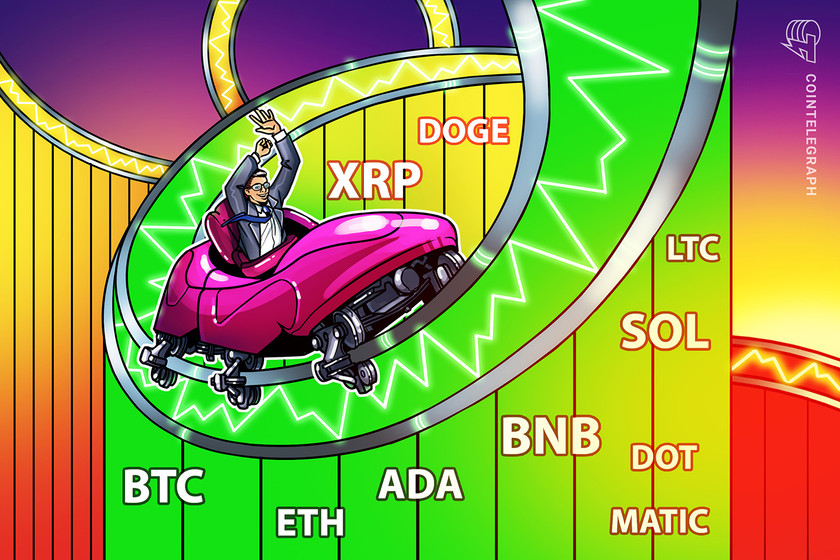Price analysis 4/17: SPX, DXY, BTC, ETH, BNB, XRP, ADA, MATIC, DOGE, SOL


Bitcoin and select altcoins are witnessing a pullback, indicating that traders may be booking profits and reducing risk.
Pullbacks are a part and parcel of uptrends. They not only help shake out the weaker hands but also offer an opportunity for traders to add to their position or make fresh entries. Currently, Bitcoin (BTC) is witnessing a correction as bulls and bears battle for control, but is this a buying opportunity or the start of a trend reversal?
The Crypto Fear & Greed Index has risen to 69, indicating that traders have started to get greedy again. When this happens, it is time to become cautious in the near term, as when new traders begin chasing prices higher, experienced traders sell into strength and buy on dips.


ARK Invest CEO Cathie Wood said in a recent interview that Bitcoin and Ether (ETH) are being considered safe-haven assets like gold. Meanwhile, Bridgewater Associates founder Ray Dalio does not consider Bitcoin to be “an effective store hold of wealth or a medium of exchange.” He called it “a very, very poor alternative to gold.” This shows that some legacy investors are still uncertain about the future prospects of Bitcoin.
Will traders buy the dip in Bitcoin and the major altcoins, or could the correction deepen further? Let’s study the charts to find out.
S&P 500 index price analysis
The S&P 500 index (SPX) has been gradually moving toward the overhead resistance at 4,200. The price action of the past few days has formed an ascending triangle pattern, which will complete on a break and close above 4,200.


If that occurs, the index may start a new uptrend that has a target objective of 4,909. It is unlikely to be a straight dash higher because the buyers are likely to face stiff resistance at 4,300 and then again at 4,625.
Another possibility is that the price turns down from the current level or the overhead resistance at 4,200 and slips below the 20-day exponential moving average (EMA) (4,070). The index may then drop to the uptrend line of the triangle. If this support gives way, the advantage may turn in favor of the bears.
U.S. Dollar Index price analysis
The U.S. Dollar Index (DXY) bounced off the strong support at 100.82 on April 13, signaling that the bulls are fiercely defending the level.


The index has reached the 20-day EMA (102.32), where the bulls may face solid resistance from the bears. If the price turns down from the 20-day EMA, it will increase the possibility of a break below 100.82. The index will then complete a head-and-shoulders (H&S) pattern, which has a long-term target objective of 86.87.
Contrary to this assumption, if the price rises above the 20-day EMA, it will indicate strong buying near the 100.82 support. That may keep the index range-bound between the 200-day simple moving average (SMA) (106.33) and 100.82 for some more time.
Bitcoin price analysis
Bitcoin turned down from $31,000 on April 14, indicating profit-booking by the bulls. The bears will try to take advantage of the situation and tug the price to the 20-day EMA ($28,937).


If the price rebounds off the 20-day EMA, it will suggest that the sentiment remains positive and traders are viewing the dips as a buying opportunity.
The bulls will then make another attempt to propel the price to the stiff overhead resistance at $32,400. This remains the key level to watch for because a break and close above it may open the doors for a potential rally to $40,000.
This positive view will invalidate in the near term if the price plummets below the 20-day EMA. That may embolden the bears, who will then try to sink the BTC/USDT pair to $27,800 and later to $26,500.
Ether price analysis
Ether is in an uptrend, but it is facing resistance near the critical overhead level of $2,200. This suggests that some short-term traders may be booking profits after the strong rally in the past few days.


The ETH/USDT pair may dip down to the psychological support at $2,000 and then to the 20-day EMA ($1,930). In an uptrend, buyers generally try to defend the 20-day EMA during pullbacks.
In this case, if the price turns up from the 20-day EMA, it will suggest that lower levels are attracting buyers. That could enhance the prospects of a break above $2,200. If this level gives way, the pair may surge to $3,000.
Contrarily, if the price slumps below the 20-day EMA, it will indicate that the bulls are rushing to the exit. The pair may then descend to $1,680 and thereafter to the 200-day SMA ($1,482).
BNB price analysis
BNB (BNB) continued its northward journey and soared above the $338–$346 overhead resistance zone on April 16. However, the bulls are finding it difficult to latch on to the higher levels.


The bears are trying to pull the price back below the breakout level. If the price tumbles below $338, it may trap several aggressive bulls. That could result in a long liquidation, sinking the BNB/USDT pair to the 20-day EMA. If bulls want to keep the recovery intact, they will have to defend this level with vigor.
Alternatively, if the price turns up from the current level and rises above $350, it will indicate that bulls are in the driver’s seat. The pair may then climb to $360 and later to $400. This level is again likely to act as a formidable resistance.
XRP price analysis
After the failed attempt to thrust the price above the $0.56–$0.58 resistance zone on April 14, the bears are trying to start a correction in XRP (XRP).


If bears tug the price below the 20-day EMA ($0.50), the XRP/USDT pair may plunge to the 50% Fibonacci retracement level of $0.47. This level may witness strong buying by the bulls because if it cracks, the pair may collapse to the vital support at $0.43.
If bulls want to prevent this short-term bearish projection, they will have to drive the price above the overhead zone. If they do that, the pair may accelerate toward $0.65 and later extend the rally to $0.80.
Cardano price analysis
The up-move in Cardano’s ADA (ADA) halted near $0.46. The price may turn down and retest the breakout level from the inverse H&S pattern.


The rising 20-day EMA ($0.40) and the RSI near the overbought zone indicate that bulls have the edge. If the price snaps back from the neckline, it will suggest that bulls have flipped the level into support. The ADA/USDT pair may then resume its uptrend toward the pattern target of $0.60.
Contrary to this assumption, if the price continues lower and plunges below the neckline, it will suggest that the bears are active at higher levels. That may trap several aggressive bulls and sink the pair to the 200-day SMA ($0.35).
Related: Bitcoin sparks liquidations as analyst says BTC price may dip 12% more
Polygon price analysis
The bulls pushed Polygon’s MATIC (MATIC) above the resistance line of the symmetrical triangle pattern on April 16, but they are struggling to sustain the breakout.


If bears succeed in pulling the price back below the resistance line, it will suggest a lack of demand at higher levels. The MATIC/USDT pair may then extend its stay inside the triangle for a few more days.
The 20-day EMA ($1.13) has turned up gradually, and the RSI is in the positive territory, indicating that the bulls are at a slight advantage. If the price turns up from the resistance line, it will indicate that the bulls have flipped the level into support. The pair may then rally to $1.30, where the bears may again mount a strong defense.
Dogecoin price analysis
The bears tried to stall Dogecoin’s (DOGE) recovery at the 38.2% Fibonacci retracement level of $0.09 between April 14 to 16, but the buyers did not cede ground to the sellers.


The buyers asserted their supremacy and kicked the price above the overhead resistance on April 17, but the long wick on the candlestick shows that the sellers are protecting the 61.8% retracement level at $0.10.
Sellers will try to strengthen their position by dragging the price below the moving averages. If they succeed, the DOGE/USDT pair may stay inside the large range between $0.07 and $0.11 for a few more days.
Contrarily, if the price turns up from the current level and rises above $0.10, it will suggest that bulls are attempting a comeback. The pair may then rise to the crucial resistance at $0.11. A break above this level will signal a possible pick-up in momentum.
Solana price analysis
Solana’s SOL (SOL) has been sustaining above the downtrend line since April 11, indicating that the bulls are in no hurry to book profits.


The 20-day EMA has started to turn up, and the RSI is in the positive zone, indicating that the bulls have the upper hand. However, the bears are unlikely to give up easily. They will try to guard the overhead resistance at $27.12.
If the price turns down sharply from this level, the SOL/USDT pair may fall to the 20-day EMA. If the price rebounds off the 20-day EMA with strength, it will enhance the prospects of a rally toward $39.
On the contrary, if the price breaks below the 20-day EMA, it will suggest that the pair may oscillate between $15.28 and $27.12 for a while longer.
The views, thoughts and opinions expressed here are the authors’ alone and do not necessarily reflect or represent the views and opinions of Cointelegraph.
This article does not contain investment advice or recommendations. Every investment and trading move involves risk, and readers should conduct their own research when making a decision.































































